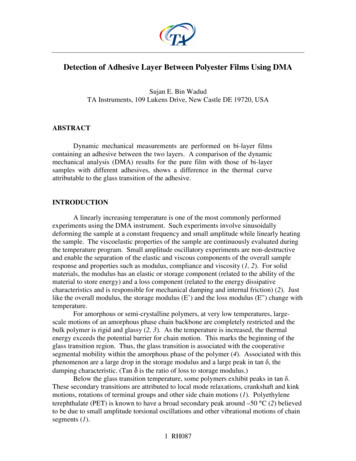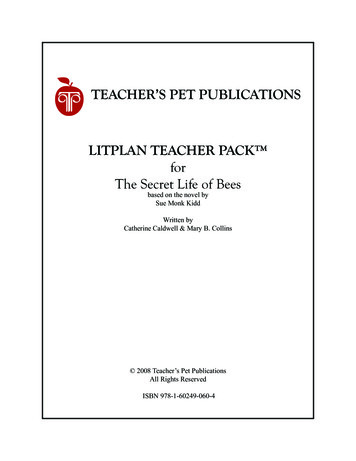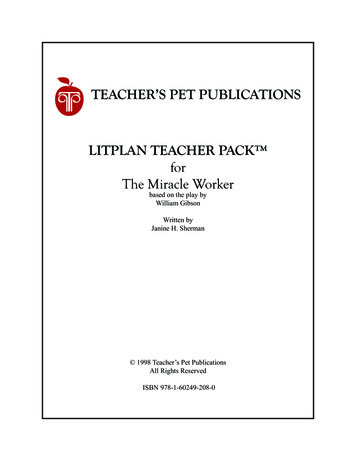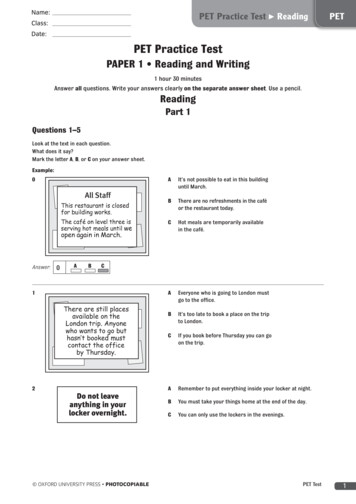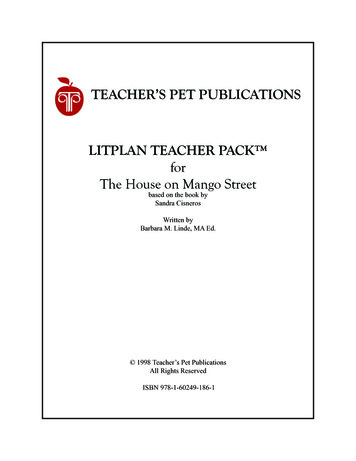
Transcription
TEACHER’S PET PUBLICATIONSLITPLAN TEACHER PACK forThe House on Mango Streetbased on the book bySandra CisnerosWritten byBarbara M. Linde, MA Ed. 1998 Teacher’s Pet PublicationsAll Rights ReservedISBN 978-1-60249-186-1
TABLE OF CONTENTS - The House on Mango StreetIntroduction5Unit Objectives8Unit Outline9Reading Assignment Sheet10Study Questions13Study Questions (multiple choice)21Vocabulary Worksheets35Daily Lessons45Writing Assignment 148Writing Evaluation Form49Nonfiction Assignment Sheet50Oral Reading Evaluation56Writing Assignment 262Extra Discussion/Writing Assignments 65Writing Assignment 374Vocabulary Review Activities76Unit Review Activities77Unit Tests83Unit Resource Materials113Vocabulary Resource Materials131
A FEW NOTES ABOUT THE AUTHORSANDRA CISNEROSCISNEROS, SANDRA (b. 1954) Sandra Cisneros was born in 1954 in Chicago, Illinois. Her father isMexican and her mother is Mexican-American. She has six brothers. During her childhood, the familymoved frequently between Mexico City and Chicago. She recalls a great deal of loneliness from theconstant moves as well as from not having a sister. Cisneros was very shy, and spent a great deal of timereading. The Little House was her favorite book, because it described the kind of stable family home shelonged for.Cisneros wrote in secret during her elementary school years. By the time she was in high school she waswriting poetry and editing the school literary magazine. While in a creative writing class in college in 1974she began writing seriously, and developing her own unique voice. She received her B. A. in English fromLoyola University in Chicago, and her M. A. from the writing program at the University of Iowa. since shewas the only minority female in the class, she felt like an outsider. This feeling led her to develop her uniquewriting style.The House on Mango Street was her first book, written in 1983. Her other works are:My Wicked Ways, (1987); "Ghosts and Voices: Writing from Obsession," Americas Review, 15 (Spring1987): 69-73; "Notes to a Young(er) Writer," Americas Review, 15 (Spring 1987): 74-76; "DO YouKnow Me? I Wrote The House On Mango Street," Americas Review 15 (Spring 1987): 77-79; WomanHollering Creek and Other Stories (1991) and Loose Woman: Poems (1994).Ms. Cisneros currently lives and writes in San Antonio, Texas4
INTRODUCTIONThis unit has been designed to develop students' reading, writing, thinking, listening and speaking skillsthrough exercises and activities related to The House on Mango Street by Sandra Cisneros. It includestwenty lessons, supported by extra resource materials.The introductory lesson introduces students to one main theme of the novel, growing up as a minorityfemale, through a KWL activity. Following the introductory activity, students are given an explanation ofhow the activity relates to the book they are about to read.The reading assignments are approximately twenty-five pages each; some are a little shorter while othersare a little longer. Students have approximately 15 minutes of pre-reading work to do prior to each readingassignment. This pre-reading work involves reviewing the study questions for the assignment and doingsome vocabulary work for 6 to 10 vocabulary words they will encounter in their reading.The study guide questions are fact-based questions; students can find the answers to these questions rightin the text. These questions come in two formats: short answer or multiple choice. The best use of thesematerials is probably to use the short answer version of the questions as study guides for students (sinceanswers will be more complete), and to use the multiple choice version for occasional quizzes. It might bea good idea to make transparencies of your answer keys for the overhead projector.The vocabulary work is intended to enrich students' vocabularies as well as to aid in the students'understanding of the book. Prior to each reading assignment, students will complete a two-part worksheetfor approximately 8 to 10 vocabulary words in the upcoming reading assignment. Part I focuses onstudents' use of general knowledge and contextual clues by giving the sentence in which the word appearsin the text. Students are then to write down what they think the words mean based on the words' usage.Part II gives students dictionary definitions of the words and has them match the words to the correctdefinitions based on the words' contextual usage. Students should then have an understanding of the wordswhen they meet them in the text.After each reading assignment, students will go back and formulate answers for the study guide questions.Discussion of these questions serves as a review of the most important events and ideas presented in thereading assignments.After students complete extra discussion questions, there is a vocabulary review lesson which pulls togetherall of the separate vocabulary lists for the reading assignments and gives students a review of all of thewords they have studied.5
Following the reading of the book, two lessons are devoted to the extra discussion questions/writingassignments. These questions focus on interpretation, critical analysis and personal response, employinga variety of thinking skills and adding to the students' understanding of the novel. These questions are doneas a group activity. Using the information they have acquired so far through individual work and classdiscussions, students get together to further examine the text and to brainstorm ideas relating to the themesof the novel.The group activity is followed by a reports and discussion session in which the groups share their ideasabout the book with the entire class; thus, the entire class gets exposed to many different ideas regardingthe themes and events of the book.There are three writing assignments in this unit, each with the purpose of informing, persuading, or havingstudents express personal opinions. The first assignment is to inform: students will read a piece of nonfiction related to The House on Mango Street and write a brief report on the piece. The secondassignment is to persuade: students will take the role of one character and argue persuasively with anothercharacter. The third assignment is to express a personal opinion: students will write a memoir of their ownin the style of Sandra Cisneros.The nonfiction reading assignment for this unit will be done in conjunction with Writing Assignment #1.Students are required to read a piece of nonfiction related in some way to The House on Mango Street.After reading their nonfiction pieces, students will fill out a worksheet on which they answer questionsregarding facts, interpretation, criticism, and personal opinions. During one class period, students make oralpresentations about the nonfiction pieces they have read. This not only exposes all students to a wealth ofinformation, it also gives students the opportunity to practice public speaking.The review lesson pulls together all of the aspects of the unit. The teacher is given four or five choices ofactivities or games to use which all serve the same basic function of reviewing all of the informationpresented in the unit.The unit tests come in two formats: all multiple choice-matching-true/false or with a mixture of matching,short answer, and composition. As a convenience, two different tests for each format have been included.There are additional support materials included with this unit. The resource materials sections includessuggestions for an in-class library, crossword and word search puzzles related to the novel, and extravocabulary worksheets. There is a list of bulletin board ideas which gives the teacher suggestions for bulletinboards to go along with this unit. In addition, there is a list of extra class activities the teacher could choosefrom to enhance the unit or as a substitution for an exercise the teacher might feel is inappropriate for his/herclass. Answer keys are located directly after the reproducible student materials throughout the unit. Thestudent materials may be reproduced for use in the teacher's classroom without infringement of copyrights.No other portion of this unit may be reproduced without the written consent of Teacher's Pet Publications.6
UNIT PLAN ADAPTATIONSBlock ScheduleDepending on the length of your class periods, and the frequency with which the class meets, youmay wish to choose one of the following options:! Complete two of the daily lessons in one class period.! Have students complete all reading and writing activities in class.! Assign all reading to be completed out of class, and concentrate on the worksheets anddiscussions in class.! Assign the projects from Daily Lesson Fifteen at the beginning of the unit, and allowtime each day for students to work on them.! Use some of the Unit and Vocabulary Resource activities during every class.Gifted & Talented / Advanced Classes! Emphasize the projects and the extra discussion questions.! Have students complete all of the writing activities.! Assign the reading to be completed out of class and focus on the discussions in class.! Encourage students to develop their own questions.ESL / ELD! Assign a partner to help the student read the text aloud.! Tape record the text and have the student listen and follow along in the text.! Give the student the study guide worksheets to use as they read.! Provide pictures and demonstrations to explain difficult vocabulary words and concepts.7
UNIT OBJECTIVES The House on Mango Street1. Through reading The House on Mango Street students will analyze characters and their situationsto better understand the themes of the novel.2. Students will demonstrate their understanding of the text on four levels: factual, interpretive, critical,and personal.3. Students will practice reading aloud and silently to improve their skills in each area.4. Students will enrich their vocabularies and improve their understanding of the novel through thevocabulary lessons prepared for use in conjunction with it.5. Students will answer questions to demonstrate their knowledge and understanding of the main eventsand characters in The House on Mango Street.6. Students will practice writing through a variety of writing assignments.7. The writing assignments in this are geared to several purposes:a. To check the students' reading comprehensionb. To make students think about the ideas presented by the novelc. To make students put those ideas into perspectived. To encourage critical and logical thinkinge. To provide the opportunity to practice good grammar and improve students' use ofthe English language.8. Students will read aloud, report, and participate in large and small group discussions to improve theirpublic speaking and personal interaction skills.8
UNIT OUTLINE - The House on Mango Street1IntroductionWritingAssignment 123PVRHouse on MangoStreet-LaughterStudy ?sHouse-LaughterMini-LessonVoice786PVRAlicia-A RiceSandwichOral ReadingEvaluation11Writing Conf.PVR RafaelaWhat Sally Said16IndependentWorkStudy ?sAlicia-RicePVR ChanclasBorn BadStudy ?sChanclasBorn BadMini-LessonFig. Lang.12?s Elenita-SallyPVR TheMonkey GardenMango SaysGoodbye13Study ?sMonkey-Mango1718NonfictionPresentationsExtra DiscussionQuestionsVocabularyReview4PVRGil's FurnitureThere Was anOld Woman5Study ?sGil's-Old WomanMini-LessonCharacter Dev.9WritingAssignment 210QuizHouse-Born BadPVR Elenita-NoSpeak English14WritingAssignment 3Projects19Unit ReviewP Preview Study Questions V Do Vocabulary Worksheet R Read91520Test
READING ASSIGNMENT SHEET - House on Mango StreetDate AssignedAssignmentCompletion DateThe House On Mango St. - LaughterGil's Furniture - There Was An Old WomanAlicia Who Sees Mice - A Rice SandwichChanclas - Born BadElenita, Cards - No SpanishRafaela Who Drinks Coconut - What Sally SaidThe Monkey Garden - Mango Says GoodbyeWRITING ASSIGNMENT LOG - House on Mango StreetDate AssignedAssignmentWriting Assignment 1Writing Assignment 2Writing Assginment 3Project10Completion Date
LESSON ONEStudent Objectives1. To receive books and other related materials (study guides, reading assignment)2. To relate prior knowledge to the new material3. To develop research skills4. To write to inform by developing and organizing facts to convey information5. To begin Writing Assignment #1 and the Nonfiction assignmentActivity #1Show students pictures of barrio life in a major city such as Los Angeles or Chicago. Then do agroup KWL Sheet with the students. Some students will know something about Sandra Cisneros orThe House on Mango Street and will have information to share. Put this information in the K column(What I Know.) Ask students what they want to find out from reading the book and record this in theW column (What I Want to Find Out.) Keep the sheet and refer back to it after reading the book.Complete the L column (What I Learned) at that time.Activity #2Distribute the materials students will use in this unit. Explain in detail how students are to use thesematerials.Study Guides Students should preview the study guide questions before each reading assignment toget a feeling for what events and ideas are important in that section. After reading the section, studentswill (as a class or individually) answer the questions to review the important events and ideas from thatsection of the book. Students should keep the study guides as study materials for the unit test.Reading / Writing Assignment Sheet You need to fill in the reading and writing assignment sheet tolet students know when their reading has to be completed. You can either write the assignment sheet ona side blackboard or bulletin board and leave it there for students to see each day, or you can duplicatecopies for each student to have. In either case, you should advise students to become very familiar withthe reading assignments so they know what is expected of them.Unit Outline You may find it helpful to distribute copies of the Unit Outline to your students so theycan keep track of upcoming lessons and assignments. You may also want to post a copy of the UnitOutline on a bulletin board and cross off each lesson as you complete it.Extra Activities Center The Unit Resource portion of this unit contains suggestions for a library ofrelated books and articles in your classroom as well as crossword and word search puzzles. Make anextra activities center in your room where you will keep these materials for students to use. Bring thebooks and articles in from the library and keep several copies of the puzzles on hand. Explain tostudents that these materials are available for students to use when they finish reading assignments or45
WRITING ASSIGNMENT #1 - House on Mango StreetPROMPTYou are reading a semi-autobiographical novel about the life of a young Hispanic American girl.The setting is present day, in the Latino section of Chicago. In order to better understand the novel, youmust first understand more about the author / narrator's cultural heritage and background.PREWRITINGYour teacher may assign a topic or allow you to choose one. You will then go to the library toresearch the topic. Look for encyclopedias, books, magazine articles, videos, and Internet sources.You may want to interview an expert on the topic of your choice.Think of questions you have about your topic. Write each one on a separate index card. Then readto find the answers, and write them on the cards. Also take notes on interesting and important facts,even if you did not have questions about them. Put each fact on a separate card. Make sure to cite yourreferences. That means to write down the title of the book or article, the author, and the page numberfor each one.Arrange your note card in the order you want to use for your paper. Number them, perhaps in theupper right hand corner. Read through them to make sure they make sense in that order. Rearrange asnecessary.DRAFTINGIntroduce your topic in the first paragraph. Tell why you chose it, and give a preview of what therest of the paper will be about. Then write several paragraphs about the topic. Each paragraph shouldhave a main idea and supporting details. Your last paragraph should summarize the information in thereport.PEER CONFERENCE/REVISINGWhen you finish the rough draft, ask another student to look at it. You may want to give the studentyour note cards so he/she can double check for you and see that you have included all of theinformation. After reading, he or she should tell you what he/she liked best about your report, whichparts were difficult to understand or needed more information, and ways in which your work could beimproved. Reread your report considering your critic's comments and make the corrections you thinkare necessary.PROOFREADING/EDITINGDo a final proofreading of your report, double-checking your grammar, spelling, organization, andthe clarity of your ideas.PUBLISHINGFollow your teacher's directions for making a final copy of your report.48
A FEW NOTES ABOUT THE AUTHOR SANDRA CISNEROS CISNEROS, SANDRA (b. 1954) Sandra Cisneros was born in 1954 in Chicago, Illinois. Her father is . The House on Mango Street was her first book, written in 1983. Her other works are: My Wicked Ways, (1987); "Ghosts and Voices: Writing from Obsession," Americas Review, 15 (Spring


